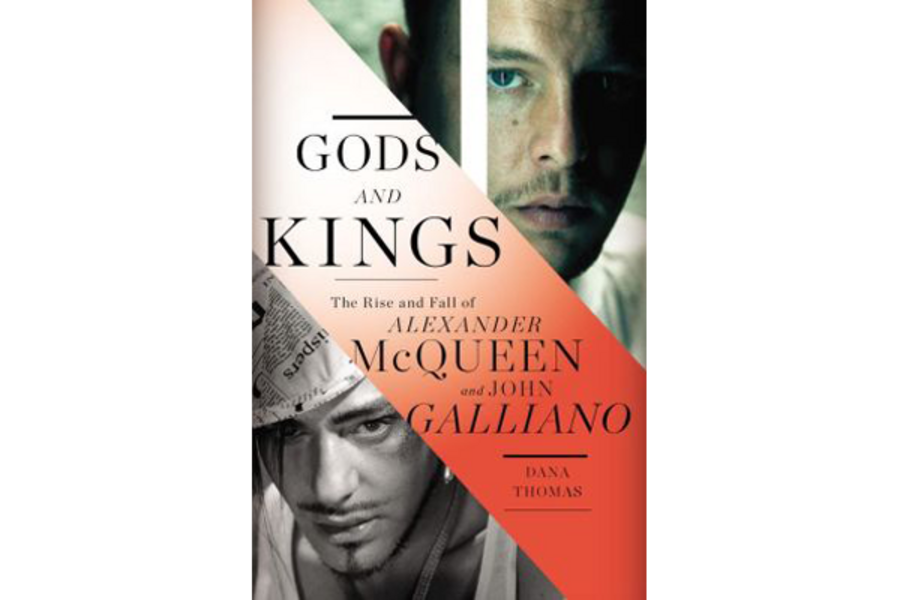'Gods and Kings' chronicles the rise and fall of fashion icons Alexander McQueen and John Galliano
Loading...
Fashion is a spectacular way to disappear. People execute this notion in numerous forms, intentionally or not – whether they wear baggy silhouettes to mask a self-conscious physicality, or put on pricey labels to cover up class anxiety. Fashion designers have their own special opportunity when it comes to this. They invent entirely new creative worlds, and sacrifice their names and energy to maintain and sell their idealized visions.
Two men, born Lee Alexander McQueen and Juan Carlos Antonio Galliano-Guillén, did just that, while simultaneously revitalizing and changing the entire industry with their talent. In Gods and Kings: The Rise and Fall of Alexander McQueen and John Galliano, author Dana Thomas details how both designers’ namesake labels rose to high acclaim – and how both lost themselves to self-destruction.
The Paris-based journalist Thomas quotes Claire Wilcox, senior curator, department of furniture, textiles, and fashion for the Victoria and Albert Museum, to sum up the feeling behind each designer’s work: “With Galliano you got a sense of the flamboyant possibilities of fashion – beautifully absurd, he intoxicated us with excess. And there was always a fusion and a dissonance between the present and the past, as if you were witnessing fashion history through the immediacy of the moment,” she says. “With McQueen, there was a sense of danger – you went to his shows and didn’t know what to expect – and you felt you were witnessing the future.”
Thomas compares Galliano and McQueen to a yin and yang relationship, and quotes McQueen on the subject: “John’s a hopeless romantic and I’ve become a hopeless realist. But you need both in the world.” Fun fact: Thomas also reveals that the two British designers had opposing opinions on Posh Spice (McQueen: meh; Galliano: “Posh and Becks, they’re gods”).
Fashion has a way of predicting what’s to come, but never would I have guessed each of these designer’s most iconic prints – McQueen's skulls and Galliano’s reimagining of newspapers – could each so eerily represent each designer’s downfall. In 2010, McQueen was found dead in his apartment as a result of suicide, and one year later, Galliano was dismissed from his creative director posts at Dior and his namesake brand after news broke that he was arrested for drunkenly shouting anti-Semitic slurs. Once considered the kings of fashion, these tragic events ended a golden age that these two men had transformed and ruled. In the two decades that straddled the new millennium, McQueen and Galliano matured from dirt-broke nobodies to fashion designers that lived like rock stars, while challenging the world to see their complicated views of beauty. They injected modern sex appeal (and profitability) into stagnant legacy brands while building names for themselves as creative geniuses. Today, business goals and Instagram followers mean far more to fashion than art.
Those familiar with Thomas, author of "Deluxe: How Luxury Lost Its Luster," are well aware of her abilities to break down the illusions of the fashion industry. She believes there were several reasons that contributed to the two designers’ downfalls: the crushing pressures in the new corporatization and democratization of fashion, the use of substance abuse as a coping mechanism, and the personal loss of family and close friends.
With the industry expanding and focusing on brand hype, fashion became a very different place from when McQueen and Galliano entered the game (the mid ‘80s and early ‘90s, respectively). A financially successful fashion brand in our current day and age has to grow to have a godlike presence – with no room for human error. Thomas points out that at the beginning of Galliano’s career, he was responsible for two collections at year. At the time of his firing, with his Dior and Galliano labels combined, it was 32.
Thomas weaves the stories of the designers’ careers beginning with their childhoods, which she notes are full of similarities. Both designers came from modest upbringings in London (Galliano’s father was a plumber; McQueen’s a cab driver), and both had adoring mothers who encouraged their creativity (the death of McQueen’s mother in fact, is considered by Thomas to play a role in his decision to take his own life). Each also knew they were gay from a young age, were subjected to assaults, and as a result, developed explosive temperaments and the ability to fight back with cutting remarks. They both attended the renowned London art school Central Saint Martins, and partied heavily in club scenes. Sensitive readers take note: Thomas does not hold back on dramatic, messy details of a tortured creative’s life, and some quotes verge on "Zoolander" and VH1’s "Behind the Music" territory.
The best way to follow this book is to keep YouTube handy, ready to queue up any old runway shows at a moment’s mention by Thomas. Words don’t quite do justice to the storytelling within great fashion, and while there are some fantastic photos in the book, it’s important to see the movement, the lighting, the attitude, and a collection as a whole. Tip: Watch the opening look, then fast-forward to the end to watch the finale, where each model comes out at once. You’ll even see Galliano and McQueen take their bows – and sometimes in this moment, especially their earlier shows, they don’t look like gods or kings, but purely happy boys.






